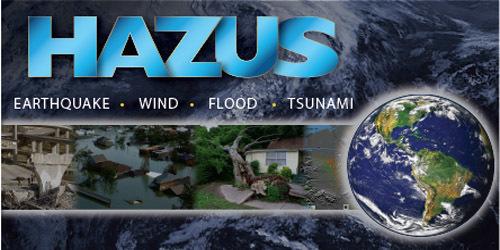This page discusses FEMA's Hazus program an d related news updates. This page is intended for Hazus users and other parties interested in using Hazus to support risk-informed decision making efforts by estimating potential losses from earthquakes, floods, hurricanes, and tsunamis and visualizing the effects of such hazards.
d related news updates. This page is intended for Hazus users and other parties interested in using Hazus to support risk-informed decision making efforts by estimating potential losses from earthquakes, floods, hurricanes, and tsunamis and visualizing the effects of such hazards.
Download Hazus Today: Users can download the Hazus software for free from the FEMA Flood Map Service Center (MSC) at https://msc.fema.gov/portal/resources/hazus
Have any interesting Hazus research or success stories to share? Want to get involved with the Hazus program by attending the monthly National Hazus User Group call? Reach out to the Hazus Outreach Team at hazus-outreach@riskmapcds.com with questions, comments, or to be added to the monthly call invitation.
 Sign up to receive updates regarding the Hazus program, training opportunities, and conferences.
Sign up to receive updates regarding the Hazus program, training opportunities, and conferences.
Hazus News
Service Pack 1 for Hazus 4.2: Service Pack 1 for Hazus 4.2 was released on May 25, 2018. This update enhances usability and utility of Hazus 4.2 by fixing latent bugs, enhancing hazard methodologies, and improving import and export processes. Get more details on this update at the Hazus Releases page, and download the executable on FEMA’s Map Service Center.
Hazus: FEMA's Methodology For Estimating Potential Losses from Disasters
Hazus is a nationally applicable standardized methodology that contains models for estimating potential losses from earthquakes, floods, and hurricanes. Hazus uses Geographic Information Systems (GIS) technology to estimate physical, economic, and social impacts of disasters. It graphically illustrates the limits of identified high-risk locations due to earthquake, hurricane, flood, and tsunami. Users can then visualize the spatial relationships between populations and other more permanently fixed geographic assets or resources for the specific hazard being modeled, a crucial function in the pre-disaster planning process.
permanently fixed geographic assets or resources for the specific hazard being modeled, a crucial function in the pre-disaster planning process.
Hazus is used for mitigation and recovery, as well as preparedness and response. Government planners, GIS specialists, and emergency managers use Hazus to determine losses and the most beneficial mitigation approaches to take to minimize them. Hazus can be used in the assessment step in the mitigation planning process, which is the foundation for a community's long-term strategy to reduce disaster losses and break the cycle of disaster damage, reconstruction, and repeated damage. Being ready will aid in recovery after a natural disaster.
Potential loss estimates analyzed in Hazus include:
- Physical damage to residential and commercial buildings, schools, critical facilities, and infrastructure;
- Economic loss, including lost jobs, business interruptions, repair, and reconstruction costs;
- Social impacts, including estimates of shelter requirements, displaced households, and population exposed to scenario floods, earthquakes, and hurricanes, and tsunamis
As the number of Hazus users continues to increase, so do the types of uses. Increasingly, Hazus is being used by states and communities in support of risk assessments that perform economic loss scenarios for certain natural hazards and rapid needs assessments during hurricane response. Other communities are using Hazus to increase hazard awareness.
Hazus Success Stories
Success stories and interesting news items that feature the use of Hazus are highlighted and documented on the Hazus Success Stories page. If you or your organization have recently participated in an exercise using Hazus or you have a story to report on related to Hazus, reach out to the Hazus Outreach Team and perhaps your story will be featured here as well!
Recent Updates to Hazus
Service Pack 1 for Hazus 4.2 delivered enhancements and bug fixes and was released on May 25, 2018. Service Pack 1 was delivered to 4.2 users via the Auto-Update Patching Tool, and no reinstallation or separate download is necessary unless your firewall prevents automatic downloads. To download the executable, please visit the FEMA MSC download page.
On January 29, 2018, the Hazus Team deployed release 4.2. This Hazus version is available on the MSC Download page. This release is a full-versioned software release with a number of key highlights, listed in the "What's New in 4.2" document.
Hazus 4.2 also includes an update from North American Datum 1983 (NAD83) to the World Geodetic System 1984 (WGS84) in order to better support U.S. territories and long-term goals for international hazard modeling. For more information on this update please see the "Hazus Coordinate Change" document.
For details about upcoming changes to the Hazus software or the history of Hazus upgrades and changes over the years, check out the Hazus Releases page to learn more.
Technical Support
Technical assistance is available via the Hazus Help Desk at hazus-support@riskmapcds.com.
Users can also call the FEMA Map Information Exchange (FMIX) at 1-877-336-2627 as an alternative means of support. The FMIX gives Hazus users the ability to speak directly with a support representative during normal business hours to follow up on Help Desk tickets, receive assistance in using the Help Desk, or get answers to general questions about Hazus.
Downloading Hazus
Federal, state, and local government agencies and the private sector can download the latest version of Hazus free-of-charge online by visiting the FEMA Flood Map Service Center (MSC).
International users may download the Hazus software, but not the U.S. state or territory datasets. International users who require technical assistance downloading the software may email the Technical assistance is available via the Hazus Help Desk at hazus-support@riskmapcds.com.
